Starbucks Company: Matrix Organizational Structure Analysis Report
VerifiedAdded on 2021/05/31
|10
|2824
|74
Report
AI Summary
This report provides a comprehensive analysis of the matrix organizational structure employed by Starbucks. It begins by defining the matrix structure and explaining its key features within the company, including functional, geographical, product-based divisions, and teams. The report then delves into the benefits of this structure, such as resource coordination, specialization, improved communication, customer satisfaction, and enhanced competitive advantage. Conversely, the report also explores the disadvantages, including psychological stress, conflicts, inefficiency, and increased costs. The report concludes with recommendations, such as maintaining competitive pricing, to mitigate the challenges and optimize the effectiveness of the matrix structure. Overall, the analysis highlights how Starbucks leverages its organizational structure to achieve global success and maintain its position in the competitive market.
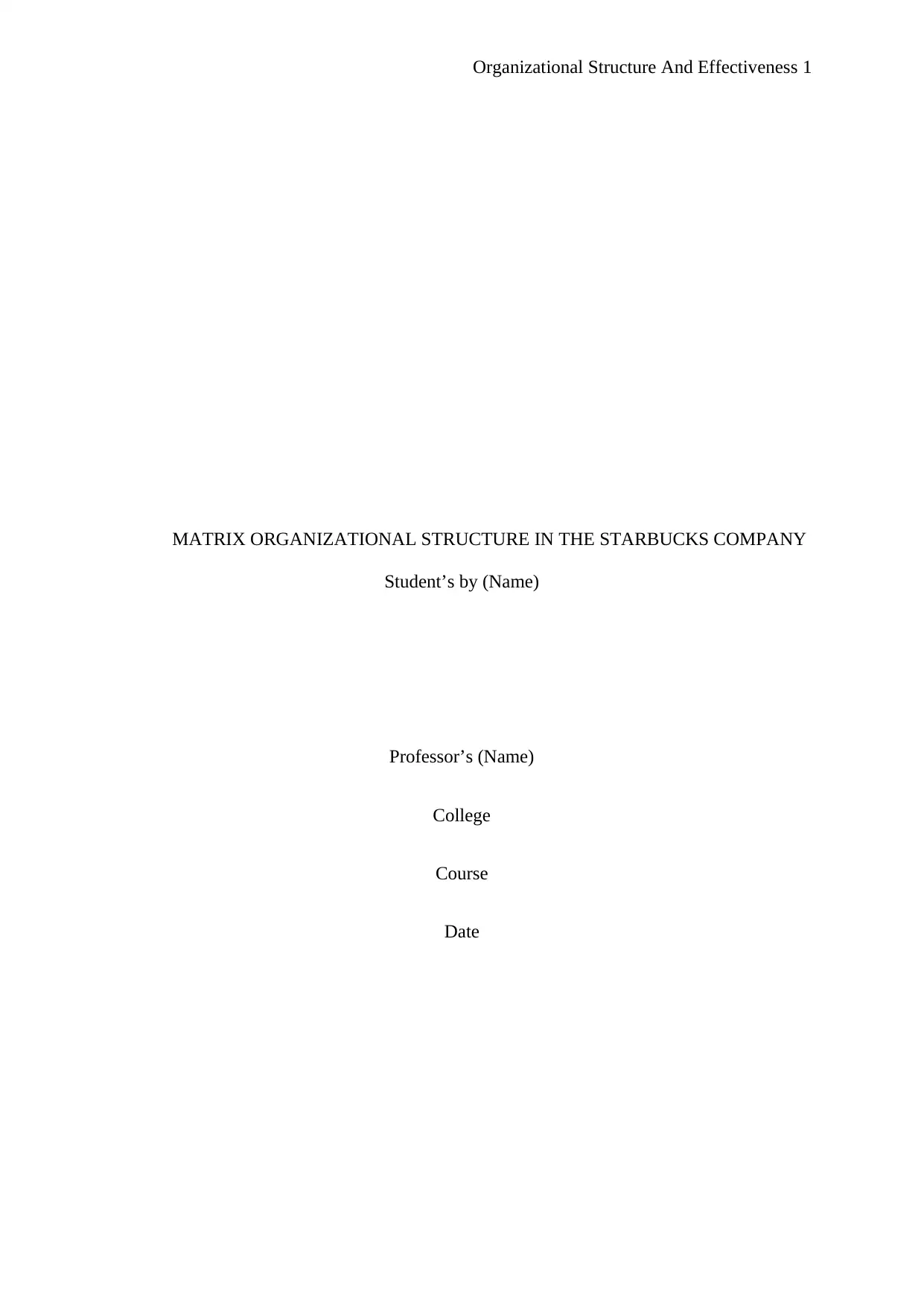
Organizational Structure And Effectiveness 1
MATRIX ORGANIZATIONAL STRUCTURE IN THE STARBUCKS COMPANY
Student’s by (Name)
Professor’s (Name)
College
Course
Date
MATRIX ORGANIZATIONAL STRUCTURE IN THE STARBUCKS COMPANY
Student’s by (Name)
Professor’s (Name)
College
Course
Date
Paraphrase This Document
Need a fresh take? Get an instant paraphrase of this document with our AI Paraphraser

Organizational Structure And Effectiveness 2
MATRIX ORGANIZATIONAL STRUCTURE IN THE STARBUCKS
COMPANY
The matrix organizational structure refers to where specialists from various functional
areas are assigned areas to work on, after which they return to their areas after the completion
of the work. Therefore, the workers have dual reporting relationships which make the
structure different from the traditional hierarchy (Marques et al., 2015, p. 302). One of the
Australian companies that use matrix organizational structure is the Starbucks Coffee
Company. It is a multinational organization, which is the largest coffeehouse in the globe.
The company’s stable leadership has been enabled by using the structure that best suits the
company. Notably, an organizational structure is the determinant of the managerial and
leadership styles to be used, the communication model, change and other factors that are
critical to the organization. The Starbucks Company has changed over years to ensure that
the business structure used is the one that meets the needs of the current market. In fact,
matrix organizational model is unique to Starbucks though it is featured in the conventional
typology of business structures. One of the notable things is that Starbucks has not developed
because of using the matrix structure but has progressed due to using a structure that meets
the demands of the organization’s needs (Snell et al. 2017). This has enabled the company
not only optimize processes but also provide quality goods and services to its customers.
The matrix organizational structure in Starbucks has several features. One is the
functional structure which refers to a grouping of workers based on their function in the
business. Some of the groups formed are the HR, finance and marketing departments. These
groups operate in the topmost positions in the organization, for example, the corporation's
headquarters (Kotabe and Helsen 2014). For instance, the human resource department
develops policies to be used in all cafes of the company. The role of the functional
department in the company is therefore to monitor top-down activities. The other matrix
MATRIX ORGANIZATIONAL STRUCTURE IN THE STARBUCKS
COMPANY
The matrix organizational structure refers to where specialists from various functional
areas are assigned areas to work on, after which they return to their areas after the completion
of the work. Therefore, the workers have dual reporting relationships which make the
structure different from the traditional hierarchy (Marques et al., 2015, p. 302). One of the
Australian companies that use matrix organizational structure is the Starbucks Coffee
Company. It is a multinational organization, which is the largest coffeehouse in the globe.
The company’s stable leadership has been enabled by using the structure that best suits the
company. Notably, an organizational structure is the determinant of the managerial and
leadership styles to be used, the communication model, change and other factors that are
critical to the organization. The Starbucks Company has changed over years to ensure that
the business structure used is the one that meets the needs of the current market. In fact,
matrix organizational model is unique to Starbucks though it is featured in the conventional
typology of business structures. One of the notable things is that Starbucks has not developed
because of using the matrix structure but has progressed due to using a structure that meets
the demands of the organization’s needs (Snell et al. 2017). This has enabled the company
not only optimize processes but also provide quality goods and services to its customers.
The matrix organizational structure in Starbucks has several features. One is the
functional structure which refers to a grouping of workers based on their function in the
business. Some of the groups formed are the HR, finance and marketing departments. These
groups operate in the topmost positions in the organization, for example, the corporation's
headquarters (Kotabe and Helsen 2014). For instance, the human resource department
develops policies to be used in all cafes of the company. The role of the functional
department in the company is therefore to monitor top-down activities. The other matrix
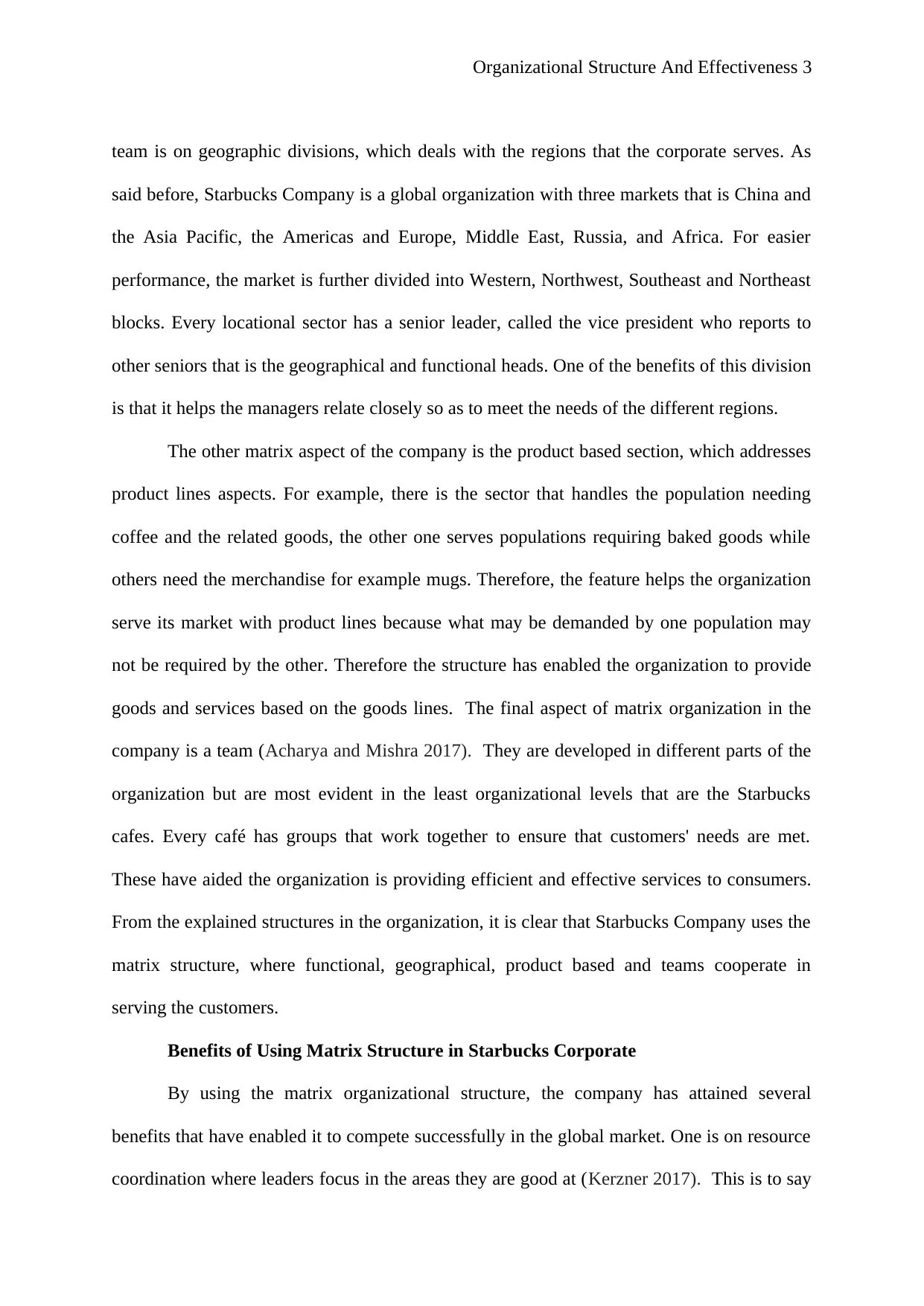
Organizational Structure And Effectiveness 3
team is on geographic divisions, which deals with the regions that the corporate serves. As
said before, Starbucks Company is a global organization with three markets that is China and
the Asia Pacific, the Americas and Europe, Middle East, Russia, and Africa. For easier
performance, the market is further divided into Western, Northwest, Southeast and Northeast
blocks. Every locational sector has a senior leader, called the vice president who reports to
other seniors that is the geographical and functional heads. One of the benefits of this division
is that it helps the managers relate closely so as to meet the needs of the different regions.
The other matrix aspect of the company is the product based section, which addresses
product lines aspects. For example, there is the sector that handles the population needing
coffee and the related goods, the other one serves populations requiring baked goods while
others need the merchandise for example mugs. Therefore, the feature helps the organization
serve its market with product lines because what may be demanded by one population may
not be required by the other. Therefore the structure has enabled the organization to provide
goods and services based on the goods lines. The final aspect of matrix organization in the
company is a team (Acharya and Mishra 2017). They are developed in different parts of the
organization but are most evident in the least organizational levels that are the Starbucks
cafes. Every café has groups that work together to ensure that customers' needs are met.
These have aided the organization is providing efficient and effective services to consumers.
From the explained structures in the organization, it is clear that Starbucks Company uses the
matrix structure, where functional, geographical, product based and teams cooperate in
serving the customers.
Benefits of Using Matrix Structure in Starbucks Corporate
By using the matrix organizational structure, the company has attained several
benefits that have enabled it to compete successfully in the global market. One is on resource
coordination where leaders focus in the areas they are good at (Kerzner 2017). This is to say
team is on geographic divisions, which deals with the regions that the corporate serves. As
said before, Starbucks Company is a global organization with three markets that is China and
the Asia Pacific, the Americas and Europe, Middle East, Russia, and Africa. For easier
performance, the market is further divided into Western, Northwest, Southeast and Northeast
blocks. Every locational sector has a senior leader, called the vice president who reports to
other seniors that is the geographical and functional heads. One of the benefits of this division
is that it helps the managers relate closely so as to meet the needs of the different regions.
The other matrix aspect of the company is the product based section, which addresses
product lines aspects. For example, there is the sector that handles the population needing
coffee and the related goods, the other one serves populations requiring baked goods while
others need the merchandise for example mugs. Therefore, the feature helps the organization
serve its market with product lines because what may be demanded by one population may
not be required by the other. Therefore the structure has enabled the organization to provide
goods and services based on the goods lines. The final aspect of matrix organization in the
company is a team (Acharya and Mishra 2017). They are developed in different parts of the
organization but are most evident in the least organizational levels that are the Starbucks
cafes. Every café has groups that work together to ensure that customers' needs are met.
These have aided the organization is providing efficient and effective services to consumers.
From the explained structures in the organization, it is clear that Starbucks Company uses the
matrix structure, where functional, geographical, product based and teams cooperate in
serving the customers.
Benefits of Using Matrix Structure in Starbucks Corporate
By using the matrix organizational structure, the company has attained several
benefits that have enabled it to compete successfully in the global market. One is on resource
coordination where leaders focus in the areas they are good at (Kerzner 2017). This is to say
⊘ This is a preview!⊘
Do you want full access?
Subscribe today to unlock all pages.

Trusted by 1+ million students worldwide
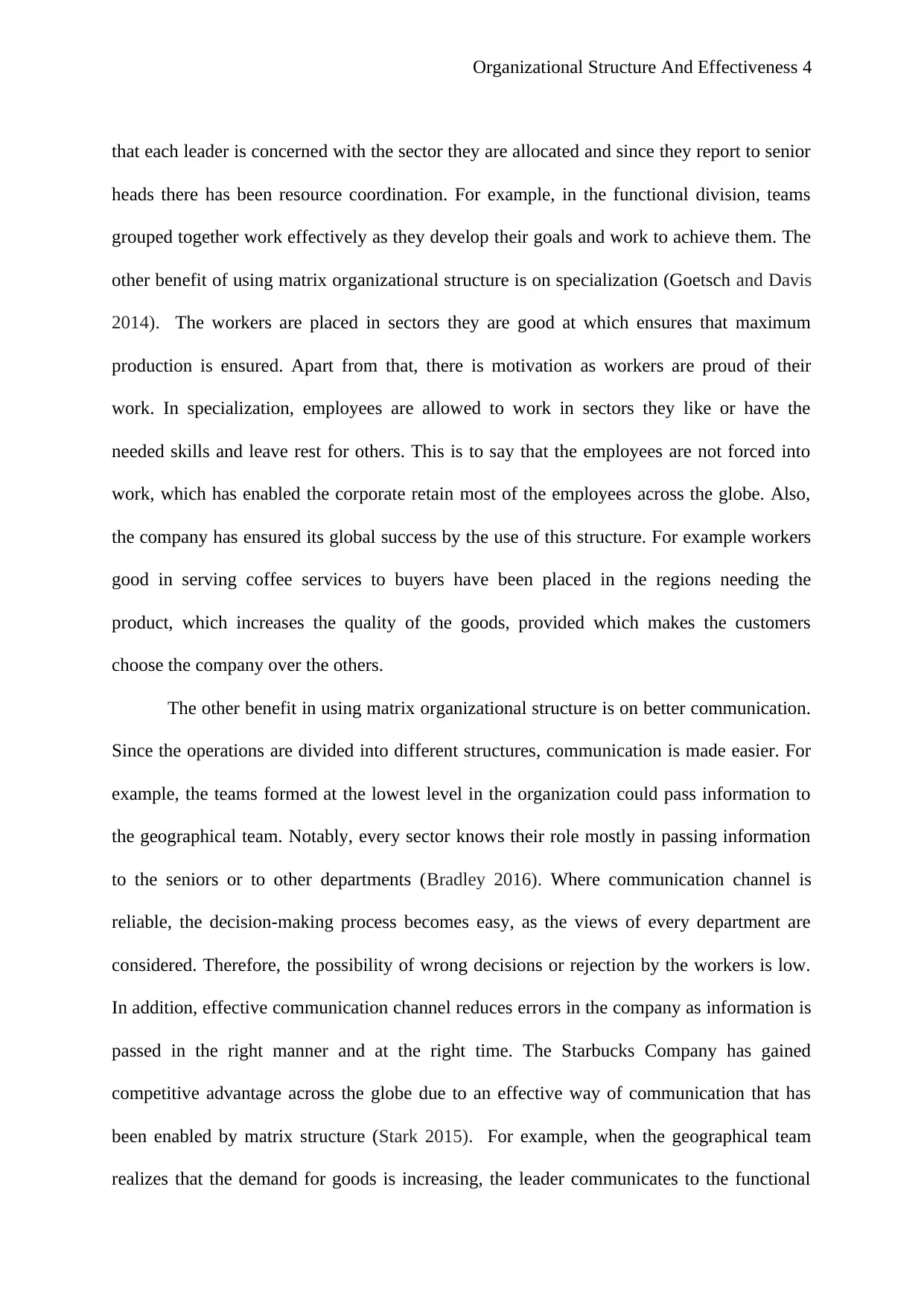
Organizational Structure And Effectiveness 4
that each leader is concerned with the sector they are allocated and since they report to senior
heads there has been resource coordination. For example, in the functional division, teams
grouped together work effectively as they develop their goals and work to achieve them. The
other benefit of using matrix organizational structure is on specialization (Goetsch and Davis
2014). The workers are placed in sectors they are good at which ensures that maximum
production is ensured. Apart from that, there is motivation as workers are proud of their
work. In specialization, employees are allowed to work in sectors they like or have the
needed skills and leave rest for others. This is to say that the employees are not forced into
work, which has enabled the corporate retain most of the employees across the globe. Also,
the company has ensured its global success by the use of this structure. For example workers
good in serving coffee services to buyers have been placed in the regions needing the
product, which increases the quality of the goods, provided which makes the customers
choose the company over the others.
The other benefit in using matrix organizational structure is on better communication.
Since the operations are divided into different structures, communication is made easier. For
example, the teams formed at the lowest level in the organization could pass information to
the geographical team. Notably, every sector knows their role mostly in passing information
to the seniors or to other departments (Bradley 2016). Where communication channel is
reliable, the decision-making process becomes easy, as the views of every department are
considered. Therefore, the possibility of wrong decisions or rejection by the workers is low.
In addition, effective communication channel reduces errors in the company as information is
passed in the right manner and at the right time. The Starbucks Company has gained
competitive advantage across the globe due to an effective way of communication that has
been enabled by matrix structure (Stark 2015). For example, when the geographical team
realizes that the demand for goods is increasing, the leader communicates to the functional
that each leader is concerned with the sector they are allocated and since they report to senior
heads there has been resource coordination. For example, in the functional division, teams
grouped together work effectively as they develop their goals and work to achieve them. The
other benefit of using matrix organizational structure is on specialization (Goetsch and Davis
2014). The workers are placed in sectors they are good at which ensures that maximum
production is ensured. Apart from that, there is motivation as workers are proud of their
work. In specialization, employees are allowed to work in sectors they like or have the
needed skills and leave rest for others. This is to say that the employees are not forced into
work, which has enabled the corporate retain most of the employees across the globe. Also,
the company has ensured its global success by the use of this structure. For example workers
good in serving coffee services to buyers have been placed in the regions needing the
product, which increases the quality of the goods, provided which makes the customers
choose the company over the others.
The other benefit in using matrix organizational structure is on better communication.
Since the operations are divided into different structures, communication is made easier. For
example, the teams formed at the lowest level in the organization could pass information to
the geographical team. Notably, every sector knows their role mostly in passing information
to the seniors or to other departments (Bradley 2016). Where communication channel is
reliable, the decision-making process becomes easy, as the views of every department are
considered. Therefore, the possibility of wrong decisions or rejection by the workers is low.
In addition, effective communication channel reduces errors in the company as information is
passed in the right manner and at the right time. The Starbucks Company has gained
competitive advantage across the globe due to an effective way of communication that has
been enabled by matrix structure (Stark 2015). For example, when the geographical team
realizes that the demand for goods is increasing, the leader communicates to the functional
Paraphrase This Document
Need a fresh take? Get an instant paraphrase of this document with our AI Paraphraser

Organizational Structure And Effectiveness 5
group which works to increase the supply to those regions. As a result, the needs of the
market are met making the buyer prefer the company. On the other hand, effective
communication ensures that issues realized in the company are solved at the right time. With
the frequent changes in the market, mistakes are common, mostly to the large organizations.
However, with a reliable communication channel, the problems are solved which prevents
them from reaching the consumers, who would easily prefer other organizations.
Customer satisfaction which leads to competitive advantage is the other benefit
realized in using matrix organizational structure (Heldman 2018). In the traditional
hierarchical system, customer satisfaction is a problem due to the rapid changes that occur in
the market. This is because; the structures formed take time to alter in meeting the needs of
the market. With matrix structure, the case is different as the structure is flexible, which
enables quick changes in meeting the needs of the market. For example, the functional
division in the market could easily form customer service teams, where issues in customer
service are identified. This is to say that the structure is helpful to the company, in meeting
the exact needs of the buyers, which ensure that they are satisfied and thus retained in the
organization. With that, the Starbucks Company has attained a competitive advantage in the
market, because quick and right decisions are made concerning needs. Mainly, this is
achieved by the manner in which the employees operate. Unlike in the traditional hierarchy
where workers have to consider the top leaders for changes to take place, matrix structure
allows them to make changes as long they are effective. By that, issues facing the buyers are
solved fast. This has made the company attract and retain customers because they are served
in the right way and challenges that come up are sufficiently solved.
Disadvantages of Matrix Structure
In using the matrix organizational structure, the Starbucks Company has experienced
several challenges while competing around the globe. One is on psychological stress as the
group which works to increase the supply to those regions. As a result, the needs of the
market are met making the buyer prefer the company. On the other hand, effective
communication ensures that issues realized in the company are solved at the right time. With
the frequent changes in the market, mistakes are common, mostly to the large organizations.
However, with a reliable communication channel, the problems are solved which prevents
them from reaching the consumers, who would easily prefer other organizations.
Customer satisfaction which leads to competitive advantage is the other benefit
realized in using matrix organizational structure (Heldman 2018). In the traditional
hierarchical system, customer satisfaction is a problem due to the rapid changes that occur in
the market. This is because; the structures formed take time to alter in meeting the needs of
the market. With matrix structure, the case is different as the structure is flexible, which
enables quick changes in meeting the needs of the market. For example, the functional
division in the market could easily form customer service teams, where issues in customer
service are identified. This is to say that the structure is helpful to the company, in meeting
the exact needs of the buyers, which ensure that they are satisfied and thus retained in the
organization. With that, the Starbucks Company has attained a competitive advantage in the
market, because quick and right decisions are made concerning needs. Mainly, this is
achieved by the manner in which the employees operate. Unlike in the traditional hierarchy
where workers have to consider the top leaders for changes to take place, matrix structure
allows them to make changes as long they are effective. By that, issues facing the buyers are
solved fast. This has made the company attract and retain customers because they are served
in the right way and challenges that come up are sufficiently solved.
Disadvantages of Matrix Structure
In using the matrix organizational structure, the Starbucks Company has experienced
several challenges while competing around the globe. One is on psychological stress as the
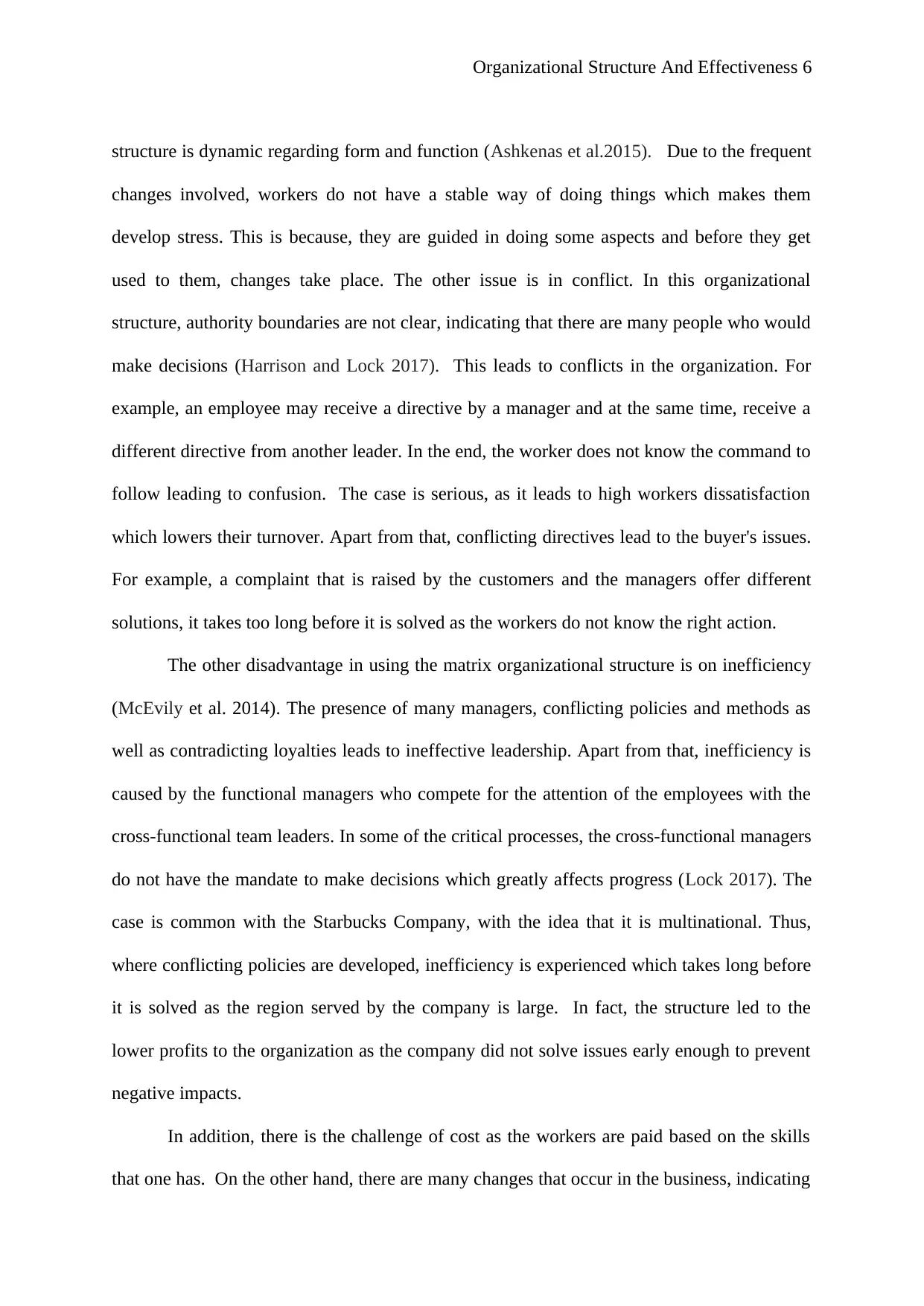
Organizational Structure And Effectiveness 6
structure is dynamic regarding form and function (Ashkenas et al.2015). Due to the frequent
changes involved, workers do not have a stable way of doing things which makes them
develop stress. This is because, they are guided in doing some aspects and before they get
used to them, changes take place. The other issue is in conflict. In this organizational
structure, authority boundaries are not clear, indicating that there are many people who would
make decisions (Harrison and Lock 2017). This leads to conflicts in the organization. For
example, an employee may receive a directive by a manager and at the same time, receive a
different directive from another leader. In the end, the worker does not know the command to
follow leading to confusion. The case is serious, as it leads to high workers dissatisfaction
which lowers their turnover. Apart from that, conflicting directives lead to the buyer's issues.
For example, a complaint that is raised by the customers and the managers offer different
solutions, it takes too long before it is solved as the workers do not know the right action.
The other disadvantage in using the matrix organizational structure is on inefficiency
(McEvily et al. 2014). The presence of many managers, conflicting policies and methods as
well as contradicting loyalties leads to ineffective leadership. Apart from that, inefficiency is
caused by the functional managers who compete for the attention of the employees with the
cross-functional team leaders. In some of the critical processes, the cross-functional managers
do not have the mandate to make decisions which greatly affects progress (Lock 2017). The
case is common with the Starbucks Company, with the idea that it is multinational. Thus,
where conflicting policies are developed, inefficiency is experienced which takes long before
it is solved as the region served by the company is large. In fact, the structure led to the
lower profits to the organization as the company did not solve issues early enough to prevent
negative impacts.
In addition, there is the challenge of cost as the workers are paid based on the skills
that one has. On the other hand, there are many changes that occur in the business, indicating
structure is dynamic regarding form and function (Ashkenas et al.2015). Due to the frequent
changes involved, workers do not have a stable way of doing things which makes them
develop stress. This is because, they are guided in doing some aspects and before they get
used to them, changes take place. The other issue is in conflict. In this organizational
structure, authority boundaries are not clear, indicating that there are many people who would
make decisions (Harrison and Lock 2017). This leads to conflicts in the organization. For
example, an employee may receive a directive by a manager and at the same time, receive a
different directive from another leader. In the end, the worker does not know the command to
follow leading to confusion. The case is serious, as it leads to high workers dissatisfaction
which lowers their turnover. Apart from that, conflicting directives lead to the buyer's issues.
For example, a complaint that is raised by the customers and the managers offer different
solutions, it takes too long before it is solved as the workers do not know the right action.
The other disadvantage in using the matrix organizational structure is on inefficiency
(McEvily et al. 2014). The presence of many managers, conflicting policies and methods as
well as contradicting loyalties leads to ineffective leadership. Apart from that, inefficiency is
caused by the functional managers who compete for the attention of the employees with the
cross-functional team leaders. In some of the critical processes, the cross-functional managers
do not have the mandate to make decisions which greatly affects progress (Lock 2017). The
case is common with the Starbucks Company, with the idea that it is multinational. Thus,
where conflicting policies are developed, inefficiency is experienced which takes long before
it is solved as the region served by the company is large. In fact, the structure led to the
lower profits to the organization as the company did not solve issues early enough to prevent
negative impacts.
In addition, there is the challenge of cost as the workers are paid based on the skills
that one has. On the other hand, there are many changes that occur in the business, indicating
⊘ This is a preview!⊘
Do you want full access?
Subscribe today to unlock all pages.

Trusted by 1+ million students worldwide
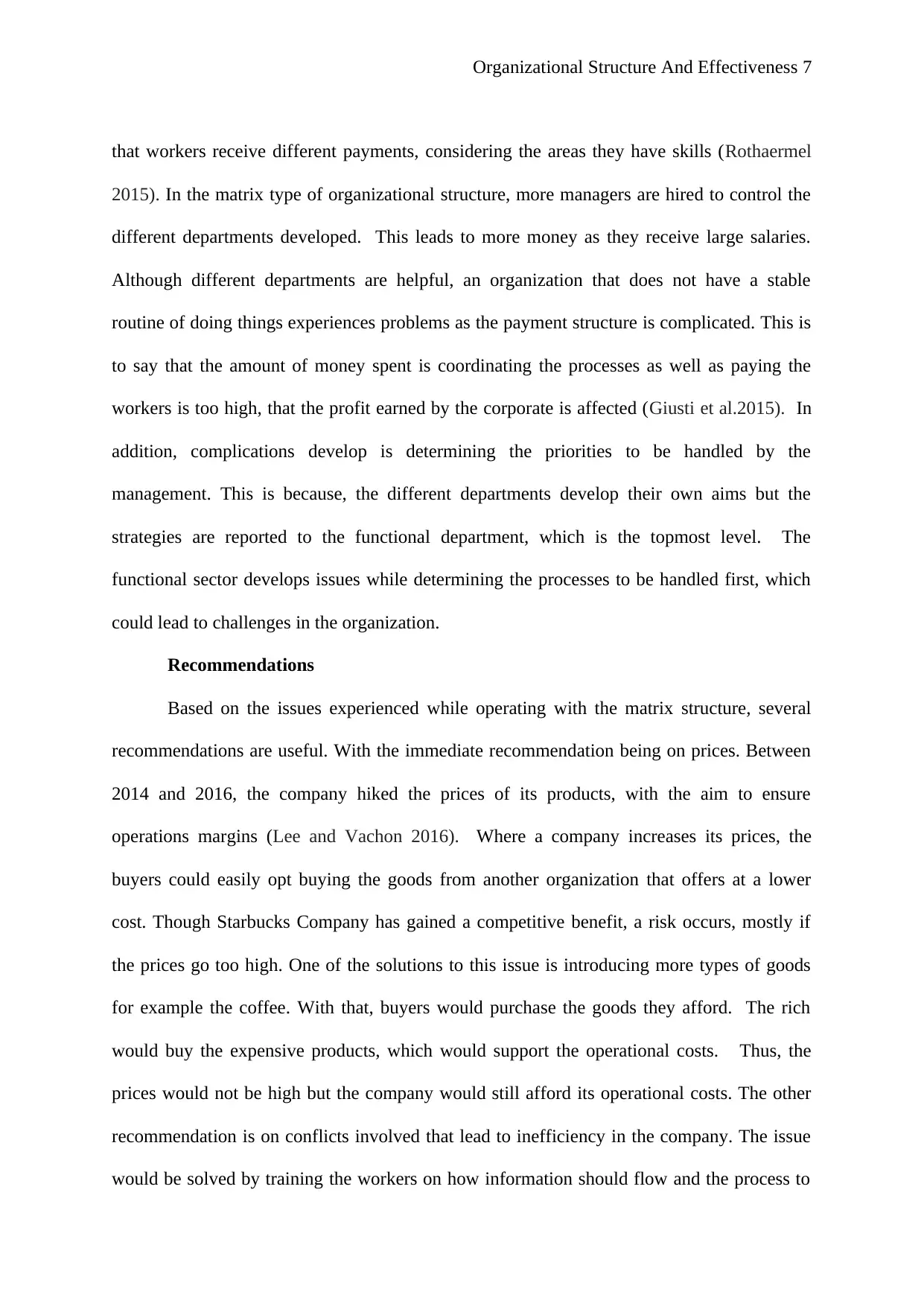
Organizational Structure And Effectiveness 7
that workers receive different payments, considering the areas they have skills (Rothaermel
2015). In the matrix type of organizational structure, more managers are hired to control the
different departments developed. This leads to more money as they receive large salaries.
Although different departments are helpful, an organization that does not have a stable
routine of doing things experiences problems as the payment structure is complicated. This is
to say that the amount of money spent is coordinating the processes as well as paying the
workers is too high, that the profit earned by the corporate is affected (Giusti et al.2015). In
addition, complications develop is determining the priorities to be handled by the
management. This is because, the different departments develop their own aims but the
strategies are reported to the functional department, which is the topmost level. The
functional sector develops issues while determining the processes to be handled first, which
could lead to challenges in the organization.
Recommendations
Based on the issues experienced while operating with the matrix structure, several
recommendations are useful. With the immediate recommendation being on prices. Between
2014 and 2016, the company hiked the prices of its products, with the aim to ensure
operations margins (Lee and Vachon 2016). Where a company increases its prices, the
buyers could easily opt buying the goods from another organization that offers at a lower
cost. Though Starbucks Company has gained a competitive benefit, a risk occurs, mostly if
the prices go too high. One of the solutions to this issue is introducing more types of goods
for example the coffee. With that, buyers would purchase the goods they afford. The rich
would buy the expensive products, which would support the operational costs. Thus, the
prices would not be high but the company would still afford its operational costs. The other
recommendation is on conflicts involved that lead to inefficiency in the company. The issue
would be solved by training the workers on how information should flow and the process to
that workers receive different payments, considering the areas they have skills (Rothaermel
2015). In the matrix type of organizational structure, more managers are hired to control the
different departments developed. This leads to more money as they receive large salaries.
Although different departments are helpful, an organization that does not have a stable
routine of doing things experiences problems as the payment structure is complicated. This is
to say that the amount of money spent is coordinating the processes as well as paying the
workers is too high, that the profit earned by the corporate is affected (Giusti et al.2015). In
addition, complications develop is determining the priorities to be handled by the
management. This is because, the different departments develop their own aims but the
strategies are reported to the functional department, which is the topmost level. The
functional sector develops issues while determining the processes to be handled first, which
could lead to challenges in the organization.
Recommendations
Based on the issues experienced while operating with the matrix structure, several
recommendations are useful. With the immediate recommendation being on prices. Between
2014 and 2016, the company hiked the prices of its products, with the aim to ensure
operations margins (Lee and Vachon 2016). Where a company increases its prices, the
buyers could easily opt buying the goods from another organization that offers at a lower
cost. Though Starbucks Company has gained a competitive benefit, a risk occurs, mostly if
the prices go too high. One of the solutions to this issue is introducing more types of goods
for example the coffee. With that, buyers would purchase the goods they afford. The rich
would buy the expensive products, which would support the operational costs. Thus, the
prices would not be high but the company would still afford its operational costs. The other
recommendation is on conflicts involved that lead to inefficiency in the company. The issue
would be solved by training the workers on how information should flow and the process to
Paraphrase This Document
Need a fresh take? Get an instant paraphrase of this document with our AI Paraphraser

Organizational Structure And Effectiveness 8
be followed in making decisions. Motivating the workers is also helpful in ensuring that they
persevere with the problems that could be experienced.
be followed in making decisions. Motivating the workers is also helpful in ensuring that they
persevere with the problems that could be experienced.

Organizational Structure And Effectiveness 9
References
Acharya, A. and Mishra, B., 2017. Exploring the relationship between organizational
structure and knowledge retention: a study of the Indian infrastructure consulting
sector. Journal of Knowledge Management, 21(4), pp.961-985.
Ashkenas, R., Ulrich, D., Jick, T. and Kerr, S., 2015. The boundaryless organization:
Breaking the chains of organizational structure. John Wiley & Sons.
Bradley, G., 2016. Benefits Realisation Management: A practical guide to achieving
benefits through change. CRC Press.
Giusti, C., Pastalkova, E., Curto, C. and Itskov, V., 2015. Clique topology reveals
intrinsic geometric structure in neural correlations. Proceedings of the National Academy of
Sciences, 112(44), pp.13455-13460.
Goetsch, D.L. and Davis, S.B., 2014. Quality management for organizational
excellence. Upper Saddle River, NJ: Pearson.
Harrison, F., and Lock, D. (2017). Advanced project management: a structured
approach. Routledge.
Heldman, K., 2018. PMP: a project management professional exam study guide. John
Wiley & Sons.
Kerzner, H. and Kerzner, H.R., 2017. Project management: a systems approach to
planning, scheduling, and controlling. John Wiley & Sons.
Kotabe, M. and Helsen, K., 2014. Global marketing management.
References
Acharya, A. and Mishra, B., 2017. Exploring the relationship between organizational
structure and knowledge retention: a study of the Indian infrastructure consulting
sector. Journal of Knowledge Management, 21(4), pp.961-985.
Ashkenas, R., Ulrich, D., Jick, T. and Kerr, S., 2015. The boundaryless organization:
Breaking the chains of organizational structure. John Wiley & Sons.
Bradley, G., 2016. Benefits Realisation Management: A practical guide to achieving
benefits through change. CRC Press.
Giusti, C., Pastalkova, E., Curto, C. and Itskov, V., 2015. Clique topology reveals
intrinsic geometric structure in neural correlations. Proceedings of the National Academy of
Sciences, 112(44), pp.13455-13460.
Goetsch, D.L. and Davis, S.B., 2014. Quality management for organizational
excellence. Upper Saddle River, NJ: Pearson.
Harrison, F., and Lock, D. (2017). Advanced project management: a structured
approach. Routledge.
Heldman, K., 2018. PMP: a project management professional exam study guide. John
Wiley & Sons.
Kerzner, H. and Kerzner, H.R., 2017. Project management: a systems approach to
planning, scheduling, and controlling. John Wiley & Sons.
Kotabe, M. and Helsen, K., 2014. Global marketing management.
⊘ This is a preview!⊘
Do you want full access?
Subscribe today to unlock all pages.

Trusted by 1+ million students worldwide
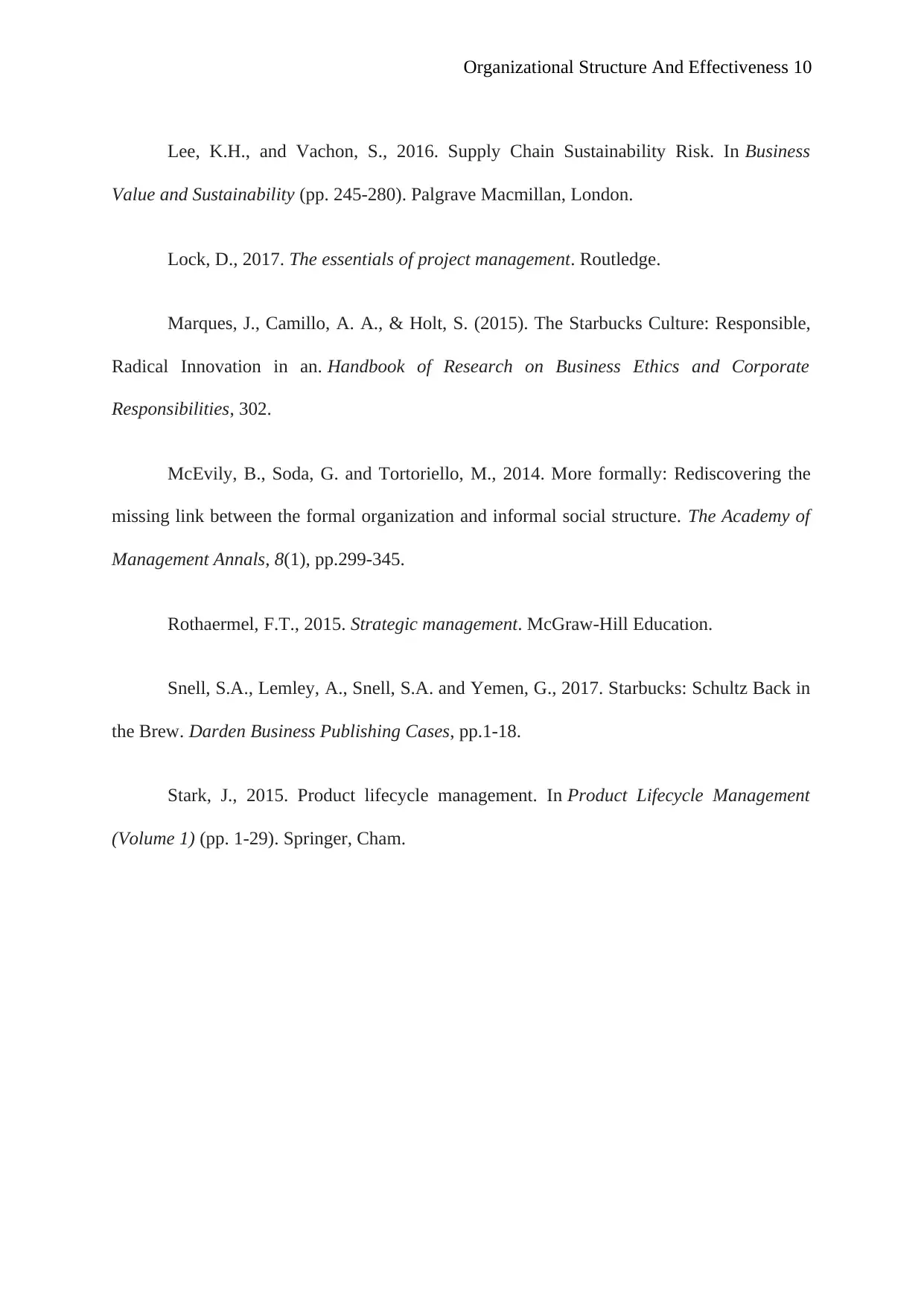
Organizational Structure And Effectiveness 10
Lee, K.H., and Vachon, S., 2016. Supply Chain Sustainability Risk. In Business
Value and Sustainability (pp. 245-280). Palgrave Macmillan, London.
Lock, D., 2017. The essentials of project management. Routledge.
Marques, J., Camillo, A. A., & Holt, S. (2015). The Starbucks Culture: Responsible,
Radical Innovation in an. Handbook of Research on Business Ethics and Corporate
Responsibilities, 302.
McEvily, B., Soda, G. and Tortoriello, M., 2014. More formally: Rediscovering the
missing link between the formal organization and informal social structure. The Academy of
Management Annals, 8(1), pp.299-345.
Rothaermel, F.T., 2015. Strategic management. McGraw-Hill Education.
Snell, S.A., Lemley, A., Snell, S.A. and Yemen, G., 2017. Starbucks: Schultz Back in
the Brew. Darden Business Publishing Cases, pp.1-18.
Stark, J., 2015. Product lifecycle management. In Product Lifecycle Management
(Volume 1) (pp. 1-29). Springer, Cham.
Lee, K.H., and Vachon, S., 2016. Supply Chain Sustainability Risk. In Business
Value and Sustainability (pp. 245-280). Palgrave Macmillan, London.
Lock, D., 2017. The essentials of project management. Routledge.
Marques, J., Camillo, A. A., & Holt, S. (2015). The Starbucks Culture: Responsible,
Radical Innovation in an. Handbook of Research on Business Ethics and Corporate
Responsibilities, 302.
McEvily, B., Soda, G. and Tortoriello, M., 2014. More formally: Rediscovering the
missing link between the formal organization and informal social structure. The Academy of
Management Annals, 8(1), pp.299-345.
Rothaermel, F.T., 2015. Strategic management. McGraw-Hill Education.
Snell, S.A., Lemley, A., Snell, S.A. and Yemen, G., 2017. Starbucks: Schultz Back in
the Brew. Darden Business Publishing Cases, pp.1-18.
Stark, J., 2015. Product lifecycle management. In Product Lifecycle Management
(Volume 1) (pp. 1-29). Springer, Cham.
1 out of 10
Related Documents
Your All-in-One AI-Powered Toolkit for Academic Success.
+13062052269
info@desklib.com
Available 24*7 on WhatsApp / Email
![[object Object]](/_next/static/media/star-bottom.7253800d.svg)
Unlock your academic potential
Copyright © 2020–2025 A2Z Services. All Rights Reserved. Developed and managed by ZUCOL.





